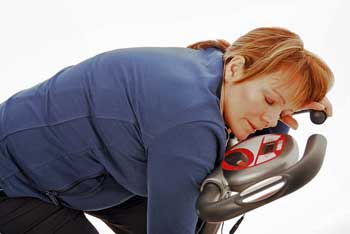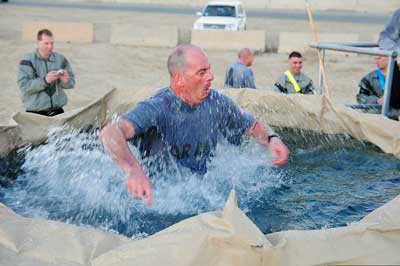

Exercise studies indicate that exercise is generally helpful for people with fibromyalgia but that’s not the end of the story. Most FM exercise studies focus on either mild or short duration exercise protocols. Sustained, high-intensity exercise, on the other hand, is often poorly tolerated. A recent study may suggest why that might be so.
The Study
This study examined the effect of 30 minutes of strenuous exercise (70% of predicted maximal heart rate) on 30 FM patients and 15 healthy controls. (The protocol appears similar to that used by Dane Cook in his ME/CFS study – see upcoming IACFS/ME blog).
They measured levels of beta-endorphin, a neuropeptide that fits onto opioid receptors like a key into a lock, triggering the release of endogenous opioids called beta -endorphins that play a critical role in reducing pain. Beta -endorphins are very effective at reducing pain; they’re 18 to 33 times stronger than morphine.
They also play a major role in stimulating the descending pain inhibition pathways. The poor performance of these pathways could account for much of the pain in FM.
During exercise beta -endorphins should kick in not just to damp down feelings of pain but also to provide feelings of well-being and even exhilaration. They’re believed likely to be responsible for a “runner’s high” – something which is surely a distant memory for many people with FM.
These neuropeptides decrease sympathetic activity (which is increased in FM), improve sleep (which is poor), and facilitate psychological stability (you be the judge).
Three studies in the 1980’s looked and failed to find decreased levels of beta-endorphins in FM patients’ cerebral spinal fluid. Those studies did not, however, include an exercise component. Plus later, a kind of very basic controversy arose that drives patients nuts, but which seems to crop up fairly frequently in medicine. It’s apparently not clear which kind of fluid (serum or PBMC’s) is the proper testing medium.
A later study (which found decreased beta-endorphin levels) suggested that serum levels don’t accurately reflect central nervous system levels – PBMC levels do.
Results
This study, which measured, ironically, serum levels, found lower levels of baseline beta-endorphins and a reduced increase during exercise in FM patients relative to healthy controls. (Because individuals can differ as to their “normal” levels of a factor, a reduced increase of a factor over time may be a more important measure. Stay tuned for the CDC’s cortisol study in the IACFS/ME conference reports for more).
The authors suggested that reduced baseline beta-endorphin levels and their lackluster rise during exercise could help explain the pain and stiffness found in FM after extensive exercise.
The study also found that the FM patients reached their maximum heart rate at an earlier stage of exercise than the healthy controls. (The exercise test went forward in stages; at each stage, the exercise got harder.) Most of the FM patients rapidly reached their maximal heart rates at stages 2 and 3 while almost all the healthy controls reached their maximal heart rates at stages 4 or later. This suggested that FM patients had to push really hard to keep up with even the early stages of the exercise test.
The authors chalked that exercise intolerance up to autonomic nervous system dysfunction and cardiovascular problems. Interestingly they suggested that the reduced exercise capacity found could be responsible for the low beta-endorphin levels. It apparently takes a certain exercise capacity to get the beta-endorphins really flowing.
They also suggested that the lower beta-endorphin levels could be causing or contributing to the allodynia many people with FM experience.
This study, unfortunately, has one howling problem; because FM participants were significantly older than the healthy controls the lowered beta-endorphin levels could reflect that age difference. The authors argued, though, that there was no evidence that the age difference would affect the rise in beta-endorphins during exercise. Clearly, more study is needed.
Treatment?
“A promising approach in the treatment of chronic pain is to mobilize the endogenous opioid system..” Bonnard et. Al.
The authors said nothing about treatment but if endogenous opioid levels are reduced in FM then increasing them should be helpful. On the new drug front, drugs that inhibit the breakdown of beta-endorphins – allowing endorphins to hang around longer, show potential. These drugs, called Enkephalinase inhibitors, are being tested in laboratory animals.
On the more alternative front Self-hacked (who else?) provides 30 ways to increase endogenous opioid levels, one of which includes taking a cold shower! (I know one brave person who finds ice baths helpful.) Other possibilities include things like massage, social interactions, acupuncture, butyrate (gut studies indicate butyrate is probably low in ME/CFS), capsaicin, marijuana, pregnenolone, kratom, transcranial magnetic stimulation, alcohol (in moderation), eating chocolate, magnesium, oxytocin (be in love / have sex), and others. (See the entire list here with recommendations on treatment options from Self-hacked).
Low-dose naltrexone (LDN) is an obvious option for ME/CFS and FM patients. LDN could be succeeding because it causes the body to pump out endorphins, blocking microglial activation, or possibly both.
- Learn More about low dose naltrexone and fibromyalgia here.
Conclusion
The unfortunate inability of this study to involve age and sex-matched controls casts a pall over its results. Still, it appears to make perfect sense that low endorphin levels could be both reducing the activity of the pain inhibition pathways in FM and be responsible for the pain that intense exercise can bring. Hopefully, larger exercise studies will follow.
If that’s so then finding ways to increase endorphin levels could provide significant help. In the meantime people with FM could use this study’s results as a reason to pamper and enjoy themselves as much as possible – and hopefully perk up those endorphin levels a bit.
Endorphins aren’t the only feel-good chemicals that may be low in FM. Check out








Do you have a writeup of the IACFS/ME conference coming?
🙂 Yes
There was a well known sports person in Australia over 10 years ago with what was CFS. Part of his recovery included ice baths! He said he always felt good for quite a time after one….it cleared his head and made him feel so much better…for a time. He eventually did recover fully. Lucky him!
Thanks for the info Cort.
Thanks Cort. I tried to see if there were any usable ENK chemicals to hack with in that research article but that is one of the more complex pharmacological ones I’ve seen and I have no idea. The self hack list…Idk. I like poppy seed fillings…
Awesome! I would caution against the ice baths for those with trigger points causing nerve impingement or allodynia caused by being too cold which could definitely trigger a flare. Best news I have heard in years. Some of the natural hacks I already use,but now have a clue for,why they help. ?
Something definitely goes on with “the right level of exercise”, as part of a multi-disciplinary approach. Since trying this as from about 3 years ago, I have steadily lifted the threshold of exertion which I am capable of sustaining without post-exertion relapse.
The irony is that for 20+ years, I was always going too hard every time I exercised, and giving myself post-exertion tension, pain, stiffness, muscle knot formation, etc. But exercising scientifically at low intensity, I have gradually become capable of physical feats that would have caused post-exercise distress and decline in the past. Not only has my threshold risen so that I can go faster/harder at “low intensity”, I can now dig deep for short intervals, more like a normal fit person, going actually anaerobic, and recover rapidly instead of leaving myself “injured” for weeks! I religiously avoided going anaerobic for nearly 3 years and have started experimenting again now I feel so good.
My favourite “sport” was always cycling, and I am really enjoying being back into it, riding with some quite competitive groups including riders half my age. Regaining any ability to run, even gently, has been a battle though, but I am slowly getting somewhere.
My massage therapists can witness to the gradual breakdown of years-old knots and taut bands and contractured muscles. Each session is now getting actual results in “releases”, which never happened in the 20 years of frustration. One of my massage therapists is an expert in the use of chunky silicon cups, and this treatment has been spectacularly beneficial recently. He can do maximum intensity treatment now on my leg muscles, when they used to be full of “rocks on fire” and every massage had to be as gentle as possible.
It makes sense if endorphins are part of the magic – I must have got them working in my favour again. I am sure that is not the only thing; when we know more, I am convinced that “recovery” will be found to be going on in multiple indicators. I am sure vaso-constriction is slowly reducing in its severity, for example. Hair mineral analyses show toxin levels falling. I am of course also following appropriate diet and supplementation advice.
Also important: abdominal breathing, and relaxation and stretching regimes that have abdominal breathing as a core principle.
Hi Philip, would you mind sharing the regimen that you followed? I would be very interested in trying this out.